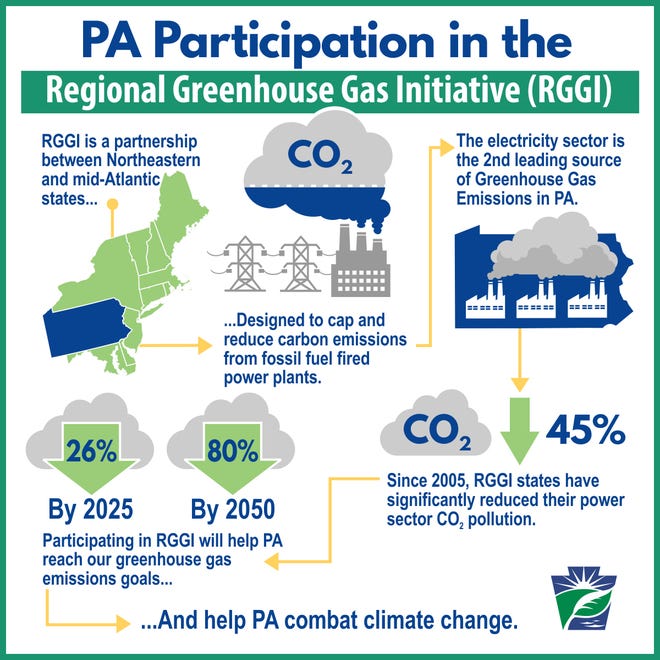
Most all the northeastern states are in the RGGI
From an Article by Rachel Wagoner, Farm & Dairy News, September 23, 2021
Pennsylvania can still hit its climate goals to reduce greenhouse gas emissions 80% by 2050, but change needs to start now, according to the leaders of several state agencies.
In a joint press conference on September 22nd with the agriculture, transportation and conservation and natural resources secretaries, Pennsylvania Department of Environmental Protection Secretary Patrick McDonnell announced the Pennsylvania Climate Action Plan 2021.
The plan details 18 actions that would help the state meet Gov. Tom Wolf’s goals to reduce emissions 26% by 2025 and 80% by 2050, compared with 2005 levels. It also laid out ways the state can adapt to the impacts of climate change already being experienced.
“If we do not step up, not only will we not reach our goal of lowering emissions, but the Pennsylvania of 2050 will be creating 1.4% more emissions than in 2005,” McDonnell said. “That’s a lot of heat waves and a lot more flooding.”
Pennsylvania Can and Should Join the Regional Greenhouse Gas Initiative (RGGI)
A big part of the plan hinges on Pennsylvania joining the Regional Greenhouse Gas Initiative.
The Independent Regulatory Review Commission voted 3 to 2 on Sept. 1 to approve the regulation for Pennsylvania to join the regional cap-and-trade program, one of the final steps before the state could officially join. The regulatory package now goes to review by the General Assembly. Some lawmakers are opposed to joining the program, saying it would cost the state jobs and hurt the economy.
While revenue from the RGGI would help, McDonnell said it isn’t critical to implementing the plan. Some of the strategies would rely on legislative action, while others could be completed with executive actions.
Agriculture Options in Pennsylvania
Agriculture Secretary Russell Redding said there are two strategies that impact agriculture: providing training and tools to implement best practices and increasing energy efficiency for agricultural operations.
Best management practices include rotational grazing, silvopasture and reducing tillage. Redding said there was a lot of overlap between best practices for water quality, which is a focus particularly in south central Pennsylvania in the Chesapeake Bay watershed, and climate change.
“We feel the pressures of climate and the changes that are occurring,” Redding said. “We feel the pressures of environmental stewardship. We feel the pressures of water quality. All of these that comes together in this discussion of and is exacerbated by the extremes.”
The strategies outlined for agriculture would have the smallest impact on reducing greenhouse gas emissions, according to the plan.
Training and tools to help farmers implement best management practices would reduce emissions by 200,000 metric tons of carbon dioxide equivalent by 2050. Increasing energy efficiency in agriculture would reduce emissions by 3000 metric tons of carbon dioxide equivalent. That’s compared with the action to create a carbon emissions-free grid, which would reduce 55.7 million metric tons of carbon dioxide equivalent.
The plan also called for increasing carbon capture and sequestration opportunities, getting more electric vehicles on the road, adopting stricter codes for new buildings and increasing the state’s alternative energy portfolio standards.
